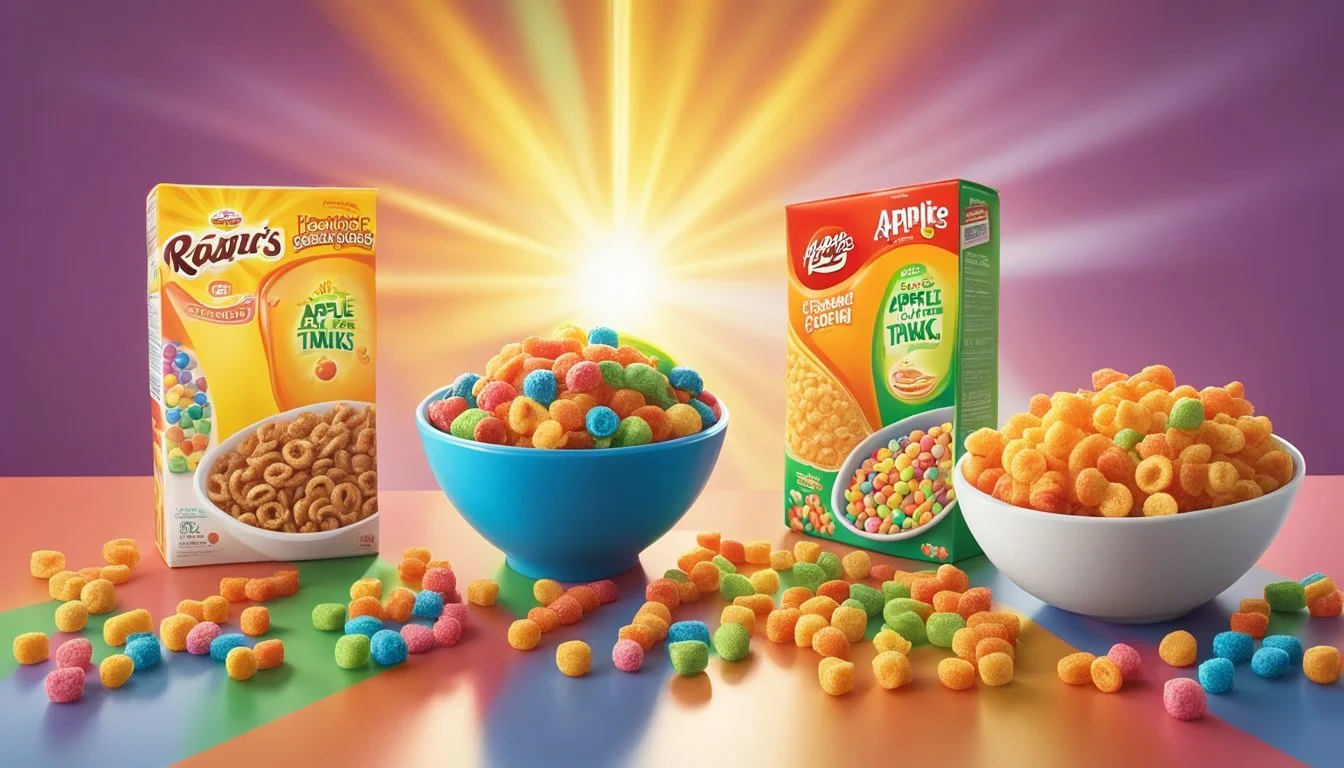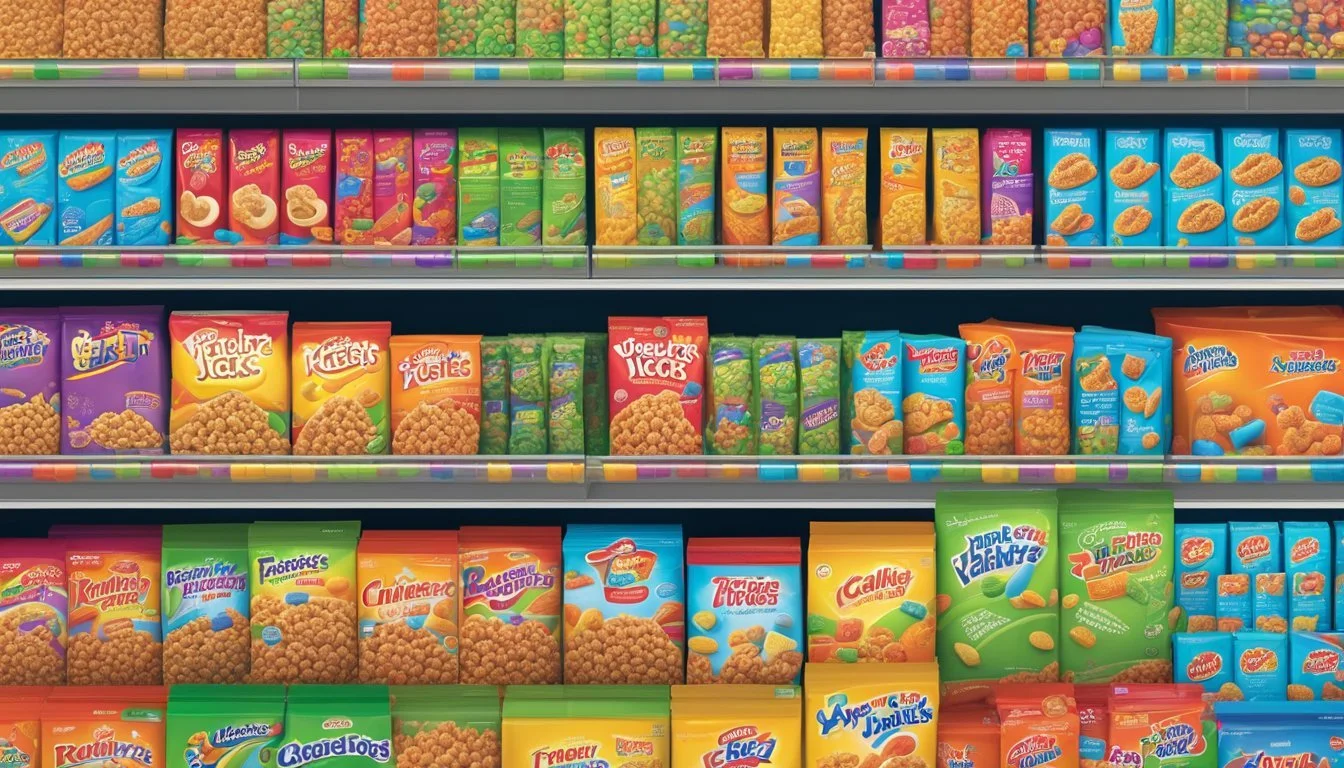Kellogg's Apple Jacks vs Trix
Comparing Flavor and Nutritional Value
This Article is Part of Our Breakfast Cereal Guide with Details on Kellogg's Apple Jacks Nutrition and Trix Nutrition
When deciding between Kellogg's Apple Jacks and General Mills' Trix, breakfast enthusiasts often find themselves weighing flavors, nutrition, and childhood nostalgia. While both cereals are beloved for their sweet taste and vibrant colors, Trix contains more vitamins and minerals compared to Apple Jacks. This nutritional edge may sway health-conscious consumers seeking a fortified breakfast option.
Kellogg's Apple Jacks, introduced in 1965, is a classic cereal known for its distinct apple and cinnamon flavor. On the other hand, Trix has captivated audiences with its fruity taste and playful shapes since its launch by General Mills. Both brands have built strong followings over the years, making it tough for fans to choose just one.
A closer look at the nutritional content reveals that Trix offers more variety in essential nutrients. Nevertheless, taste preferences and brand loyalty play significant roles in the choice between these two iconic cereals. By comparing their attributes, readers can make an informed decision on which cereal best fits their breakfast table.
Historical Background
Kellogg's Apple Jacks and Trix, both iconic cereals, have rich and distinct histories. One was born from an internship experiment, while the other emerged from a bustling mix of innovation and market demand.
Origin of Kellogg's Apple Jacks
Apple Jacks cereal was invented in 1965. A key figure in its creation was William Thilly, an intern at Kellogg. Thilly's innovative spirit led to the unique flavor and appeal of Apple Jacks, which quickly gained popularity.
Initially named "Apple O's," the cereal was a blend of apple and cinnamon flavors. The product underwent various modifications, but the core ingredients and taste remained largely unchanged.
Subsequently, Kellogg introduced several mascots to promote Apple Jacks, enhancing its market presence. Over the decades, Apple Jacks solidified its place alongside other Kellogg's favorites like Frosted Flakes and Froot Loops.
Development of Trix Cereal
Trix, a vibrant and fruity cereal, was introduced by General Mills in 1954. It captivated children with its bright colors and playful shapes, distinct from the traditional rows of cereal boxes.
Trix initially featured uniformly round pieces, later evolving to include a variety of fruit shapes. The memorable slogan, "Silly rabbit, Trix are for kids!" and its animated rabbit mascot, became deeply embedded in popular culture.
The cereal's formula has seen various changes to align with nutritional trends. Despite this, Trix has maintained its appeal through consistent branding and strategic marketing.
Nutritional Comparison
Kellogg's Apple Jacks and General Mills Trix cereals have distinct nutritional profiles that are important for making informed dietary choices. Key nutritional aspects to consider include caloric content, vitamins, minerals, macronutrients, fiber, and sugar levels.
Caloric Content Analysis
Kellogg's Apple Jacks contain approximately 70 calories per 18g serving. In comparison, General Mills Trix has around 120 calories per 1 cup (32g) serving. This difference in serving size makes it essential to consider portion control.
When evaluating caloric intake, Trix offers more calories per serving, potentially providing more energy but also more caloric density.
Vitamins and Minerals Profile
Kellogg's Apple Jacks are rich in Vitamin C, providing a notable source of this essential nutrient. General Mills Trix, on the other hand, contains a broader range of B vitamins, including Vitamins B1, B2, B6, and B12.
Both cereals offer key minerals such as iron and zinc, which are crucial for various bodily functions. However, Trix has a higher content of several vitamins and minerals compared to Apple Jacks.
Macronutrient Breakdown
Apple Jacks have a relatively low fat content at 0.5g per serving and offer 1g of protein. Trix, meanwhile, provides about 1g of fat and 2g of protein per serving.
Carbohydrate content varies as well, with Apple Jacks containing roughly 16g of carbs per serving, while Trix offers closer to 27g. This makes Trix higher in both carbs and protein, which may be preferable for specific dietary needs.
Comparative Fiber Content
Fiber is a critical component of a healthy diet. Apple Jacks only offer about 0.5g of fiber per serving, whereas Trix provides around 1g per serving.
This difference might seem small but could be significant over multiple servings, contributing to better digestive health and satiety with Trix.
Sugar Levels in Each Cereal
High sugar content is a concern for many consumers. Apple Jacks contain 14g of sugar per serving, while Trix has around 10g per serving.
This makes Trix marginally better in terms of lower sugar content, which might be beneficial for those monitoring their sugar intake.
Both cereals have their strengths and weaknesses in terms of nutrition. Understanding these differences can help in making better dietary choices.
Ingredient Breakdown
Kellogg's Apple Jacks and Trix both have unique ingredient compositions that contribute to their distinct flavors and nutritional profiles. Here, the focus will be on understanding the specifics of the ingredients used in each cereal.
Apple Jacks Ingredient List
Apple Jacks primarily contain whole grain corn flour, sugar, wheat flour, and oat fiber. Their characteristic taste comes from apple juice concentrate and cinnamon, which together give a sweet and slightly spicy flavor.
To enhance appearance, the cereal includes artificial colors like Yellow 6, Yellow 5, and Red 40. Additionally, fructose and corn syrup add to the sweetness. Vitamins and minerals are fortified, including iron and vitamin C (ascorbic acid), making it nutritious for children.
Trix Ingredient Composition
Trix is known for its vibrant colors and fruity flavors. Its main ingredients include whole grain corn and number one flour, which serve as the cereal base. The distinct sweetness comes from sugar and corn syrup, with fructose enhancing the fruity taste.
Artificial coloring agents like Red 40, Blue 1, and Yellow 6 are used for the brightly colored pieces. Trix also contains natural flavorings and is fortified with essential vitamins and minerals such as calcium carbonate and zinc oxide to support dietary needs. Its texture is often achieved with tricalcium phosphate and corn chex ingredients.
Health and Diet Considerations
Understanding the nutritional differences between Kellogg's Apple Jacks and Trix can help make healthier choices, especially for those with specific dietary needs. This section covers dietary restrictions, allergens, and compares options that suit low-fat, low-carbs, low-calories, and low glycemic index diets.
Dietary Restrictions and Allergens
Both Apple Jacks and Trix target a similar demographic but differ slightly in ingredients that may affect those with dietary restrictions.
Apple Jacks contain corn and wheat, which may be problematic for individuals with gluten sensitivities. Additionally, it has food colorings and artificial flavors. Trix, produced by General Mills, also contains corn but is gluten-free in the U.S., making it a better option for those avoiding gluten.
Both cereals contain sugar and other allergens like soy lecithin. Checking labels is essential for those with strict dietary restrictions to avoid adverse reactions.
Low Diet Options Comparison
When comparing low fat diets, Apple Jacks have an advantage, with 0 grams of fat per serving, while Trix contain 1 gram of fat. This difference can be crucial for low-fat diet followers.
For low carbs options, both cereals are somewhat comparable. Apple Jacks have 16 grams of carbohydrates per serving, while Trix come in slightly higher but details vary by portion size.
In low-calorie diets, Apple Jacks provide 70 calories per serving, lower than Trix’s 120 calories.
Regarding the glycemic index, both cereals have high sugar content, impacting blood sugar levels. Those managing diabetes or adhering to a low glycemic index diet should consume these cereals in moderation.
Both Apple Jacks and Trix offer limited fiber content, less than 1 gram per serving, which is inadequate for those seeking higher dietary fiber.
By examining these factors, individuals can better align their cereal choices with their specific health and diet goals.
Brand Influence and Market Position
Kellogg and General Mills hold substantial positions in the breakfast cereal market. Their strategic choices significantly influence consumers' purchasing behaviors.
Kellogg's Market Strategy
Kellogg employs a multifaceted strategy to maintain its market position. Innovation plays a key role in their approach, including the development of new flavors and products like Apple Jacks and Frosted Flakes. They also focus on smaller packaging to attract different consumer segments.
Marketing initiatives emphasize brand loyalty, leveraging nostalgia and tradition. Kellogg's "Kellanova" plans to drive snack sales with enhanced marketing. Their strategy also involves adapting to competitor actions, including price adjustments and promotional tactics.
Global reach is another factor. Kellogg targets diverse markets, tailoring their products and marketing campaigns to fit cultural preferences, which has been successful, for example, in India.
General Mills Brand Impact
General Mills' influence in the market is robust, thanks to strong brands like Trix. Their strategy emphasizes brand identity and health-focused marketing. General Mills positions themselves as a health-conscious choice, contrasting with some Kellogg's products which have been criticized for high sugar content.
Product innovation is equally important for General Mills. They continually adapt recipes and introduce new variants to stay relevant. Their market approach also includes strategic partnerships and advertising campaigns aimed at younger demographics.
Market competition with Kellogg includes price strategies and promotional deals that directly impact consumer preference. Additionally, General Mills leverages data to fine-tune their products' nutritional value, making frequent adjustments based on consumer trends and feedback.
Environmental and Ethical Considerations
Both Kellogg's and General Mills emphasize their commitment to sustainability and ethical practices. These initiatives focus on sustainable sourcing, reducing packaging waste, and maintaining ethical business standards.
Sustainable Practices
Kellogg's has implemented various measures aimed at sustainable production. They work to source ingredients responsibly and reduce their carbon footprint. Notable efforts include using renewable energy in their operations and promoting sustainable agriculture programs.
General Mills also has strong sustainability practices. They aim to source 100% of their top 10 priority ingredients by 2025. This includes efforts to reduce emissions and ensure water stewardship.
Packaging and Waste Reduction
Kellogg's takes significant steps to minimize environmental impact through packaging. They focus on reducing plastic usage and improving the recyclability of their packaging materials. Recently, they have been transitioning to using more plant-based and renewable materials in their packaging.
General Mills has similarly committed to reducing packaging waste. Their initiatives include designing packaging with recyclable materials and reducing excess packaging. They have set targets to achieve packaging sustainability, including the goal of having all packaging recyclable or reusable by 2030.
More on Kellogg's Apple Jacks
Cinnamon Toast Crunch vs Kellogg's Apple Jacks: Which is better?
French Toast Crunch vs Kellogg's Apple Jacks: Which is better?
Honey Nut Cheerios vs Kellogg's Apple Jacks: Which is better?
Kellogg's Apple Jacks vs Kellogg's Froot Loops: Which is better?
Kellogg's Apple Jacks vs Post GrapevsNut Flakes: Which is better?
Kellogg's Apple Jacks vs Post Raisin Bran Cereal: Which is better?








